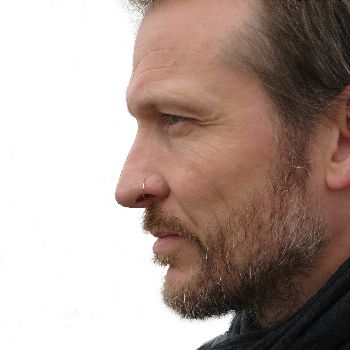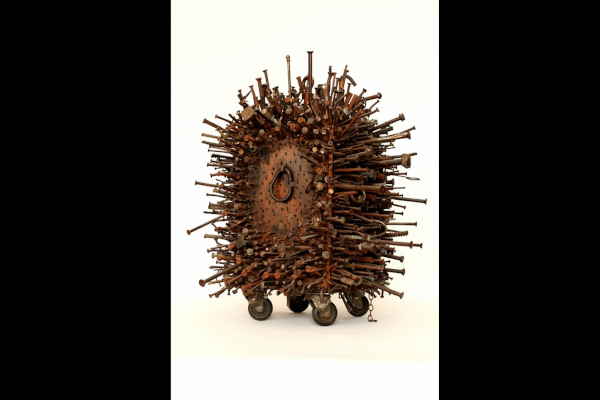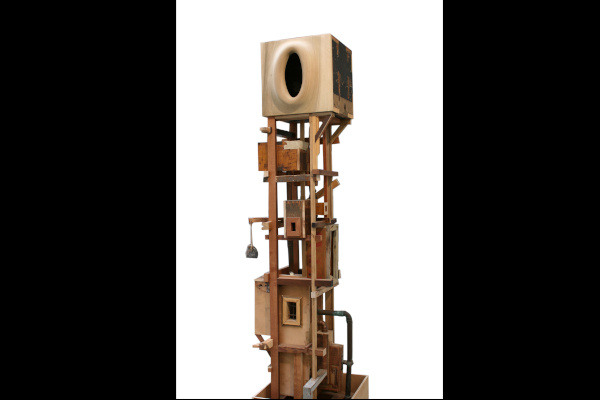: PROJECT’S TITLE
TATTOOED TUMOUR BOX
ARTIST: Wayne Chisnall
CREATION TIME: 2015
MATERIALS:
plywood, ink (metal and plywood stand)
DESCRIPTION:
This sculpture evolved from the artist’s interest in applying organic-looking structural developments (that have gone awry) to very geometric forms. In this case Chisnall has taken as his inspiration the mechanism of a cancer cell, where growth has gone unchecked and produced an unstable-looking, asymmetrical form. The ‘tattooed’ element of the piece harks back to growing up with a tattooist father but the style of the drawings relate more to his early career as a technical illustrator. As for the subject of the drawings – the starting point was based upon found materials that he had collected for use in his sculptures, but which he chose to morph together or exaggerate beyond recognition.
Chisnall says that as with most of his artistic projects, he underestimated just how long the drawing side of the work would take. There are several reasons for this. One being the fact that all the drawings are quite intricate and time consuming to develop from scratch, especially since he planned for all the elements to have their own unique qualities whilst still looking like they could coexist in the same universe. Put together, all the forty four separate planes of the sculpture’s components add up to a much larger surface area than one might expect.
Another reason that the drawing process took so long is that each sketch had to be done four separate times – firstly worked out as a pencil sketch in one of the artist’s sketchbooks, then traced in ink onto tracing paper, thirdly, transferred onto the sculpture using carbon paper and drawing over the image on the tracing paper, and finally there would be the time consuming task of inking in the carbon ghost image on the sculpture’s wooden surface.
Initially, Chisnall started off the drawing process by rendering elements of miscellaneous found objects, and morphing them together but once he got into the flow of it, and started to really develop a feel for the world that my drawings evolved from, he mostly abandoned the use of existing source materials, and opted for the freedom of simply making it all up.
To give you a little insight into the multiple processes that he ‘lovingly’ went through (often whilst working through the night, till five or six the next morning) constructing Tattooed Tumour Box, we have included a few of the pencil sketches, tracings, and inked-in sections of the sculpture’s surface.
Incidentally, the sculpture is made up of cut-up pieces of antique packing crates, sourced from the Victoria and Albert Museum. You can even see sections of old labels, stencilled numbers, and part of the lettering of “V. & A. M.”, branded into the wood in a charming early twentieth century typeface.
There are lots of drawn elements of the piece that the artist especially enjoyed creating, and one of them is the underside of the base section of the sculpture, and therefore probably the part that is least likely to be seen. So we thought that we’d give it an airing here. As the circular hole in the centre is for the insertion of the pole that makes up part of the work’s metal stand, Chisnall thought that he’d make it a feature of the overall design, and incorporated a sphincter element to the drawing. The sigils which appear within to outer ring reference occult interests as well as being a tribute to the flamboyantly entertaining comic book writer, Grant Morrison.
: ABOUT THE ARTIST
Wayne Chisnall
BIOGRAPHY
A Fine Art practitioner with a background in book, magazine, and technical illustration; UK artist, Wayne Chisnall, is now more well known for his sculptural work, paintings, drawings and prints.
He is a winner of the Royal British Society of Sculptors Bursary Award with a solid history of exhibiting nationally (an example being the Victoria and Albert Museum's 'Baroque To The Future' exhibition, in which he exhibited eight sculptures) and internationally.
As well as exhibiting in museums and art galleries his work has feature in films, TV, books and magazines; including BBC 2's 'The Culture Show', Channel 4 News, London Live, and Channel 4's 'Four Rooms'. His sculptures have appeared in the feature film, 'Scratch', directed by Jakob Rørvik, and in 2013 he was commissioned to produce a series of paintings for the horror film 'Blaze of Gory'.
The artist's work is featured regularly in on-line articles and interviews, including two separate features in The Huffington Post.
Chisnall also organises and runs art/sculpture workshops for schools and businesses, including ones for ING Bank's London headquarters via the Royal British Society of Sculptors.
John Malkovich chose Chisnall's script, 'Doppelganger', as the winning entry in the 2008 Sony VAIO Scriptwriting competition. This script, along with Malkovich's was then turned into the short animated film, 'Snow Angel’.
“I’m going to go with the “Doppelganger” script. It’s clever, inventive, and somehow both surprising and inevitable. Very neatly done all in all.”
John Malkovich (4th Jan. 2008).
As well as working on his own projects the artist accepts commissions. His clients include The Vaults London, Brooke Roberts Innovation Agency, the luxury fashion brand Éthologie by Jasper Garvida, Mary Fox Linton, Andy Martin Architects, Converse, Dawood and Tanner, Domus, Ctrl.Alt.Shift, various private collectors, and the Ping Pong restaurant chain, for whom he designed the interior artwork and decor of their new restaurant opposite Wembley Stadium.
Website: waynechisnall.blogspot.co.uk
Flickr: flickr.com/photos/waynechisnall
Twitter: twitter.com/WayneChisnall
Instagram: instagram.com/waynechisnall

ARTIST'S STATEMENT
Much of my practice involves the reworking of found objects; objects that I feel have a certain ‘resonance’. By using materials already loaded with meaning and associations I am able to play with people’s expectations and create narratives that lurch between the humorous and the uncanny.
Memory, or its fallibility, is central to my work; as is evident in pieces that incorporate or recreate childhood artefacts. An important aspect of my life-size model kit sculpture, ‘And When I'm a Man, I’ll Think as a Man’, is its colour, which was chosen to match my memory of that of a childhood toy – realizing that the memory would have mutated; exaggerating its original luridness. In an age of fake news and perceived phenomena such as the ‘Mandela Effect’ I’m eager to explore the creative possibilities of misremembering and of outright fabrication.
As well as the obvious sexual interpretation of the orifice element that's emerged in many of my recent works, my main interest in the device, lies in it being the portal between the internal and the external.
Other reoccurring motifs in my work are the box and tower; pertaining to themes of containment, the urge to possess, and mobility.
Although not a film maker myself, my work has been influenced by my early passion for film and animation. This is evident in my archaic-looking tower sculpture, ‘The City,’ which echoes the same fairy tale or dream-like quality that is characteristic of the short films of animators such as the Brothers Quay and Jan Švankmajer.
“Chisnall’s towering wooden piece is made up of tiny display cases and cabinets made from found materials like skulls, insects and fossils, a kind of modern cabinet of curiosities. Or a nightmarish vision inspired by Jorge Luis Borges. He explains that much like the inhabitants of a big city, each compartmentalised environment plays out its own narrative, seemingly oblivious to that of its neighbour”.
Julia Kollewe (journalist – The Guardian & The Independent), 2009.
“Wayne Chisnall creates art that references such things as structure, time and Modernism as they pass through a very contemporary mindset that focuses on humor, transience, functionality and futility. There is also the presence of popular culture in his thinking, as he addresses the differences between reality and perception, and how that affects the needs, wants and even the formation of the human psyche.”
D. Dominick Lambardi, 'Repurposing With a Passion', The Huffington Post, 2014.










